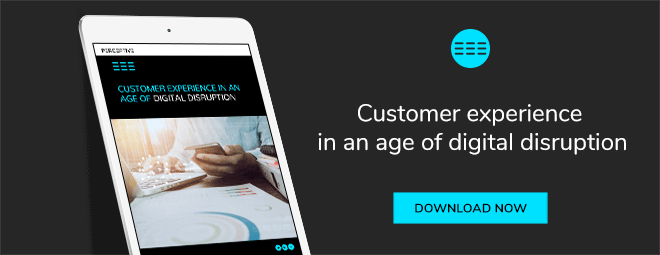Advances in social channels, media and marketing, along digital innovations in how we analyse data, are creating intelligent automation techniques and systems that will be total game changers when it comes to creating value for customers. In this blog, we'll go through a few notable digital innovation trends, the disruption that has ensued, and how these have and will continue to effect customer experience as a whole.
Read more: The Future of Business: data and digital transformation
Further customisation and on-demand services
Today’s digital influences, such as the cloud, increased mobility and cognitive computing technologies, mean that the opportunity to capitalise on the Internet of Things (IoT) is bigger than ever before.
Business processes, including the supply chain, will become more flexible. It will be easier to provide customisation of products and services on-demand, fuelled by customer needs and facilitated by anytime access to information.
For brands, these improvements mean faster, more cost-efficient flow of information, fusing business processes with intuitive consumer interaction data, ultimately providing a more powerful basis to execute from.
Related content: 5 ways to be more a profitable business with customer insights
Digital innovation is the new norm
Innovation is quickly becoming the new norm, with many global companies participating in open innovation initiatives and using APIs and technology platforms to deliver better outcomes.
For many organisations, the increase in access to and the volume of behavioural data creates challenges in relation to storage, usage and security.
In terms of customer experience, the increased amount of behavioural data means being able to demand a fair “value exchange”. If consumers share more data, they will undoubtedly expect something in return. If you want a return on investment on data and how you use it, this is a critical note to make.
Related content: Customer experience in an age of digital disruption [Free eBook]
Increase in customer retention
The effects of the IoT will mean an increase in customer retention for forward-thinking businesses, thanks to advances in technology and smart devices. Customer interactions will be managed more intuitively and negative exchanges will be reduced thanks to the ability to personalise and hone in on customers’ requirements.
According to Accenture, “customers will experience new levels of engagement with brands and their products and services”, thanks to brands becoming more intelligent and meeting customer needs more thoroughly.
For companies that want to leverage these trends, they need to establish how they can derive the most value out of the IoT. Things are moving faster than ever and for businesses to keep up, they need to be prepared for digital disruption, open to innovation and must work towards effectively managing previously unknown growth opportunities.
Related content: 5 important techniques for increasing customer retention rate
Automation is now the norm
Organisations are using automation not only to reduce costs but also to create new business/customer value, particularly when it comes to enabling self-service. One survey found that 75 per cent of respondents found self service a convenient way to address customer service issues.
Generative AI and AI tools are already rapidly transforming how many industries handle their customer interactions, from virtual customer assistants and chatbot technology to marketing automation and predictive customer service.
A recent study anticipates that 95 per cent of customer interactions will be AI-Powered by 2025. Meanwhile, Gardner has found that organisations that implemented virtual customer assistants had 70 per cent less call, chat and/or email inquiries and increased customer satisfaction.
In short, businesses will be able to achieve great competitive advantages in their field by adopting automation and AI into their processes.
Managing legacy led systems
In the face of wanting to implement advanced, automated processes, a lot of companies are dealing with legacy led systems. A big question is how this affects customer centricity and customer experience. A key point when implementing any new system or data initiative is to understand what exact data you’re missing.
What is the problem you’re trying to unlock? If you don’t understand who your customers are, perhaps you’re asking the wrong questions.
Getting a holistic view of your current state of data and creating a library of your individual databases plus your requirements is the first step to understanding your needs.
Related content: 4 steps to quality control your customer data
Turn your customers into your sales force
Progression within customer experience and communities will mean that satisfied customers can, in effect, become an active sales force. In this way, brands can create new market share and generate new streams of income through providing flexibility for their customers.
A few ways automation will save the day is by automating purchasing processes and the ways in which customers are receiving service. Customers will receive a more personalised, flexible service at a reduced cost for the business.
Though new technologies, complex tasks will become easier, which naturally impacts how businesses can serve their customers, by changing, or disrupting the needs of customers.
Services that are available today such as same day delivery and mass customisation, will become more automated in order to achieve more customer value through digital means.
Related content: The beauty of customer experience automation—go digital or go home
Learn more about how your business can succeed through digital disruption to create awesome customer experiences. Get our new e-book for free: Customer experience in an age of digital disruption.

